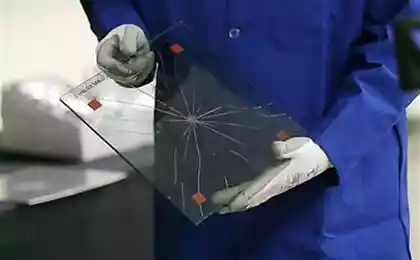698
Obedient glass
Fotoblogger anton-agarkov tells an interesting craft - the art of working with molten glass "lampwork».
38 photos
1. It all started with the fact that my sister-mistress Alina and her husband decided to go to the Pasha Master Class Julia Trubitsyna to work with glass lampwork technique. What is it, I had no idea, but since childhood I have a rooted belief that people who are able on their own to melt glass and make him all sorts of bizarre things - wizards. And this, I just could not miss, here and asked for the company. And I went to the master class course with a camera. The workshop proved to be a small room, where chaos reigned creative light. By the padded steel plates were bolted desks gas burners, and on the walls of the towering shelves filled with thin glass rods of all possible colors.

2. For each burner from fortified wall fan exhaust pipe ran.

3.

4. As I looked around, Julia ignited burner and Alina Pasha wore aprons and sat for jobs. Julia explained in a nutshell, what is the essence of lampwork technique: Master in flames of a gas burner heats the glass rod, it melts and forms the molten glass ornaments - beads, tiny figures, and everything your heart desires. Hence the word "Lamp" in the title.

5.

6.

7.

8. In any case - can not hurt. And in the corner of the workshop, I noticed a fire extinguisher.

9. The Workshop began with what Julia had taught Alina and Pasha pulling stringers - long, thin strands of glass-rods, which then need to be used to decorate the beads. And then the magic began: glass rod in the flame began to blush, and on its surface made the drop. She had to grab a pair of tweezers and slowly pull. If done correctly, it drops by to stick stretch thin glass thread. If you hurry - the thread will be too thin, too slowly will lead - will be thick and short. In general, this activity requires some skill.

10. gaining a drop, grab it with tweezers and pull meeeedlenno ...

11. Ready-stringers
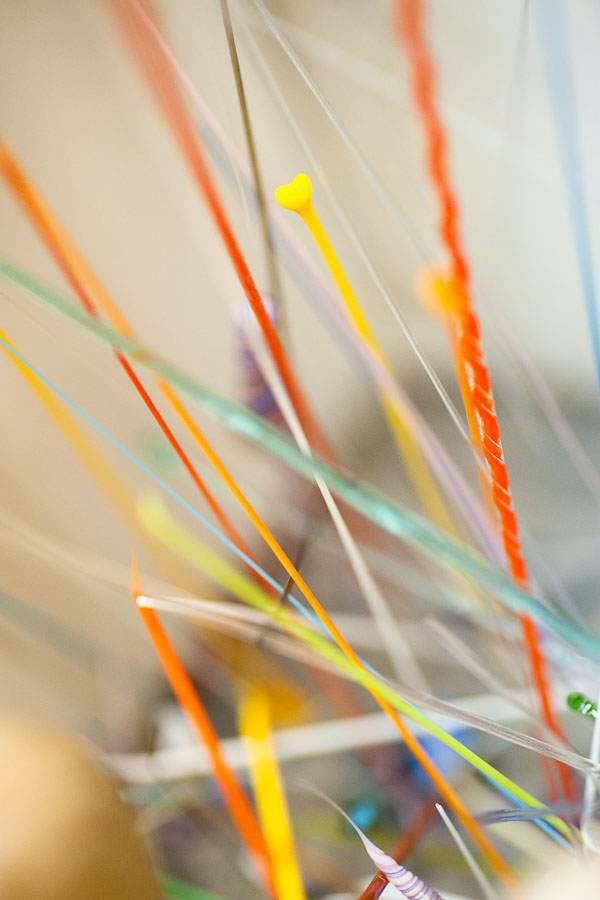
12. Meanwhile, I decided to examine more closely in the studio. On the tables were spread all sorts of devices of unknown purpose and finished beads.

13.

14. Special beads for use in the art milefiori.

15. These are the names for his glasses coming up with the Chinese ...

16. ... Or even such. Meanwhile, the guys started to take its first beads ...

17. Before forming a bead on the rod, it must be covered with a special compound - separator. If this is not done, the finished chilled bead will not be removed from the shaft. By the way, in a scientific way, this is called a mandrel rod.
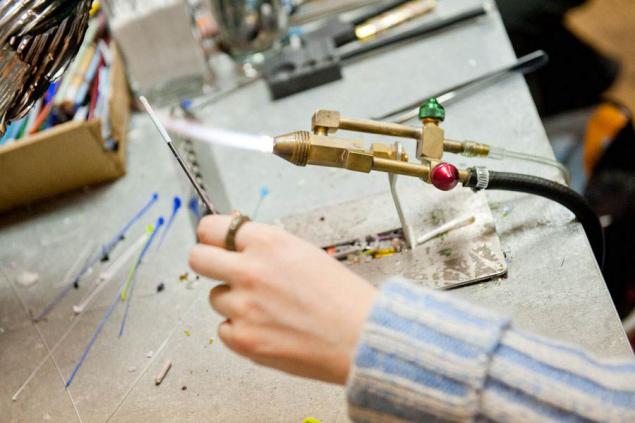
18.
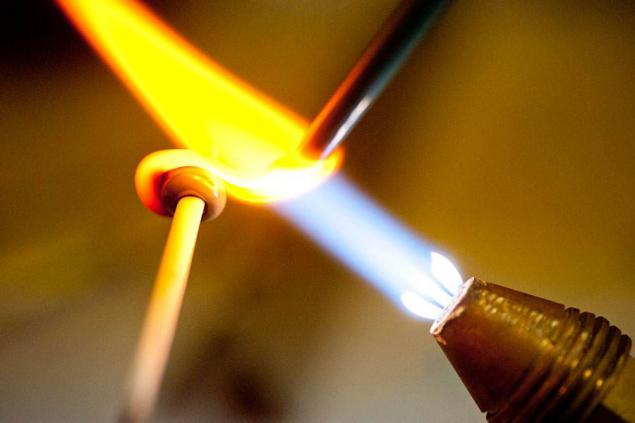
19.

20. The soft glass can be slightly corrected with tweezers. But careful not to damage the thin layer of the separator.
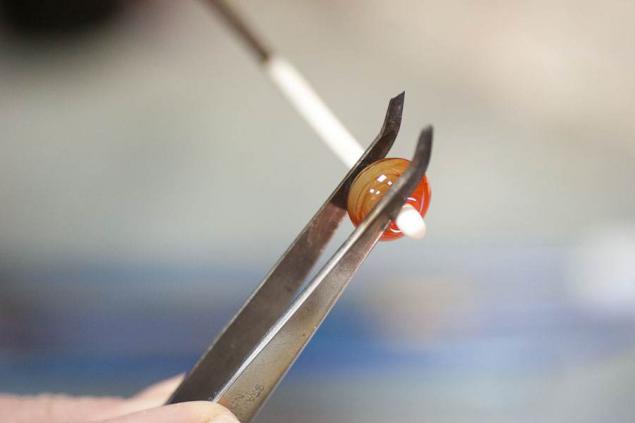
21.

22. With special graphite spatula bead can be formed into a cylindrical shape.

23
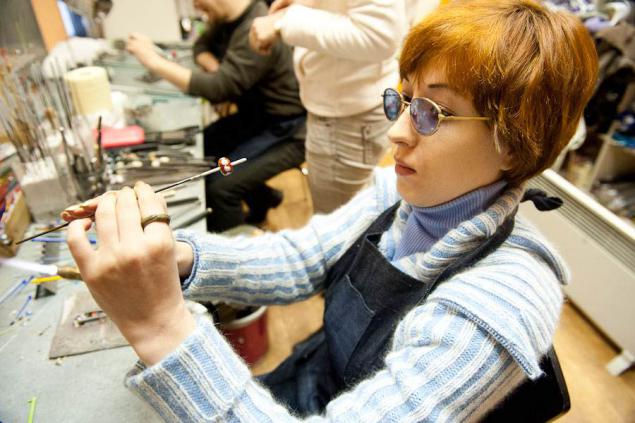
24

25

26

27. And, you can take a stringer ...
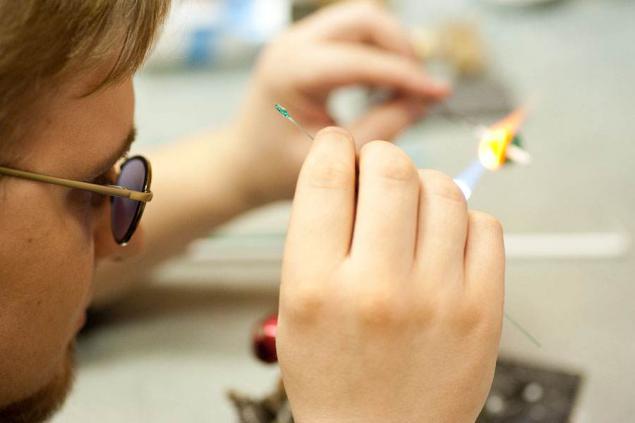
28. And put the bead on a small drop
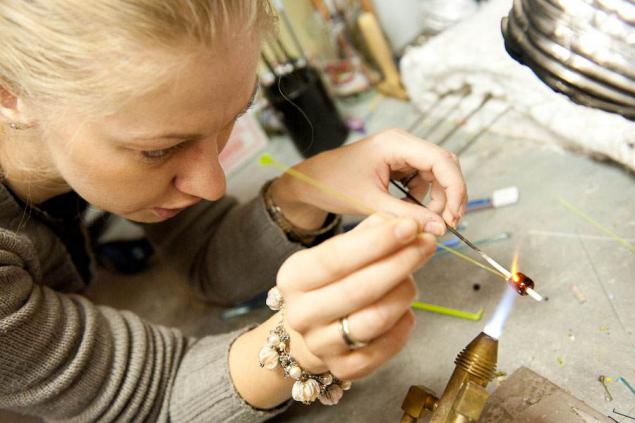
29

30. or tweezers made from round beads heart.

31. Julia conducted a master class as possible without interfering with the actions of the students. Only from time to time handing out advice, guidance and new jobs, "Slowly pull ... well, you are now on the plane was flying" or "good bead, now I want the same, but with three points." She led occupation of ease and fun, from time to time and joked playfully corrected minor missteps beginners glaziers
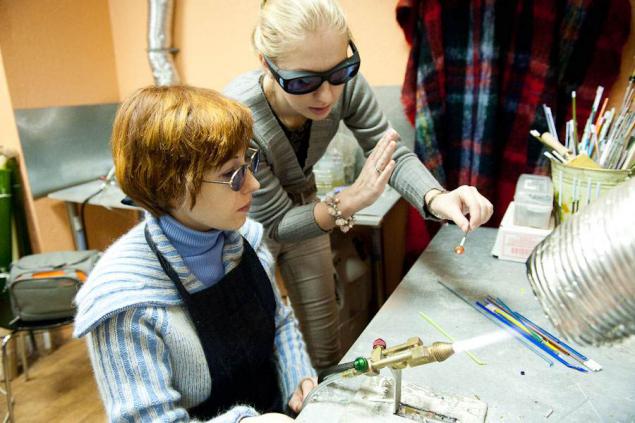
32. And if a bead with an awl to poke ...

33. ... and the puncture site to fill clear glass ...

34. That in the thickness of the glass bubbles appear

35. All finished beads are sent under a blanket of wool - to cool slowly and cracked

36

37

38. And here they are - ready-made beads

Source:
38 photos
1. It all started with the fact that my sister-mistress Alina and her husband decided to go to the Pasha Master Class Julia Trubitsyna to work with glass lampwork technique. What is it, I had no idea, but since childhood I have a rooted belief that people who are able on their own to melt glass and make him all sorts of bizarre things - wizards. And this, I just could not miss, here and asked for the company. And I went to the master class course with a camera. The workshop proved to be a small room, where chaos reigned creative light. By the padded steel plates were bolted desks gas burners, and on the walls of the towering shelves filled with thin glass rods of all possible colors.

2. For each burner from fortified wall fan exhaust pipe ran.

3.

4. As I looked around, Julia ignited burner and Alina Pasha wore aprons and sat for jobs. Julia explained in a nutshell, what is the essence of lampwork technique: Master in flames of a gas burner heats the glass rod, it melts and forms the molten glass ornaments - beads, tiny figures, and everything your heart desires. Hence the word "Lamp" in the title.

5.

6.

7.

8. In any case - can not hurt. And in the corner of the workshop, I noticed a fire extinguisher.

9. The Workshop began with what Julia had taught Alina and Pasha pulling stringers - long, thin strands of glass-rods, which then need to be used to decorate the beads. And then the magic began: glass rod in the flame began to blush, and on its surface made the drop. She had to grab a pair of tweezers and slowly pull. If done correctly, it drops by to stick stretch thin glass thread. If you hurry - the thread will be too thin, too slowly will lead - will be thick and short. In general, this activity requires some skill.

10. gaining a drop, grab it with tweezers and pull meeeedlenno ...

11. Ready-stringers

12. Meanwhile, I decided to examine more closely in the studio. On the tables were spread all sorts of devices of unknown purpose and finished beads.

13.

14. Special beads for use in the art milefiori.

15. These are the names for his glasses coming up with the Chinese ...

16. ... Or even such. Meanwhile, the guys started to take its first beads ...

17. Before forming a bead on the rod, it must be covered with a special compound - separator. If this is not done, the finished chilled bead will not be removed from the shaft. By the way, in a scientific way, this is called a mandrel rod.

18.

19.

20. The soft glass can be slightly corrected with tweezers. But careful not to damage the thin layer of the separator.

21.

22. With special graphite spatula bead can be formed into a cylindrical shape.

23

24

25

26

27. And, you can take a stringer ...

28. And put the bead on a small drop

29

30. or tweezers made from round beads heart.

31. Julia conducted a master class as possible without interfering with the actions of the students. Only from time to time handing out advice, guidance and new jobs, "Slowly pull ... well, you are now on the plane was flying" or "good bead, now I want the same, but with three points." She led occupation of ease and fun, from time to time and joked playfully corrected minor missteps beginners glaziers

32. And if a bead with an awl to poke ...

33. ... and the puncture site to fill clear glass ...

34. That in the thickness of the glass bubbles appear

35. All finished beads are sent under a blanket of wool - to cool slowly and cracked

36

37

38. And here they are - ready-made beads

Source:






